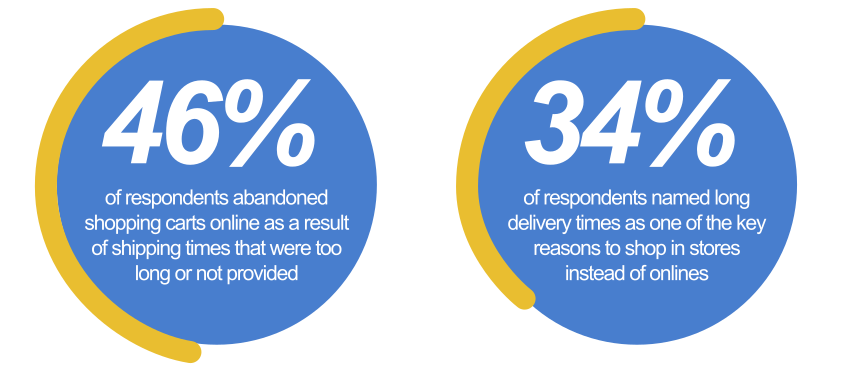“Multi-channel fulfillment strategies aren’t cutting it anymore. Instead, retailers need to invest in an omnichannel fulfillment strategy to stay ahead of their competition.”
By Meg Galgano, Senior Director Product Management
Over the last few years, consumers have put pressure on retailers to have flexibility and provide more options when it comes to shopping. Although the ever changing digital environment is a key driver, the COVID-19 pandemic and the supply chain crisis have escalated customer expectations and retailer adoption.
With these three factors, retailers have had to reimagine the customer experience and tap into different strategies such as shipping ecommerce orders from stores, ‘Buy Online Pickup in Store’, and curbside pickup.
Although all three strategies have proven to work well independently, it is now critical for retailers to ensure they work in parallel to optimize customer satisfaction and stay ahead of the competition.
Discover how an omnichannel fulfillment strategy is changing the game for retailers.
What is an omnichannel fulfillment strategy?
The term ‘omnichannel’ has flooded the retail industry…but what is an omnichannel fulfillment strategy?
Omnichannel fulfillment is an innovative strategy where retailers are able to use multiple channels (in-store, online, curbside, etc.) to fulfill and distribute customers orders, no matter what channel the consumer used to place an order. Essentially, it is combining all channels to give a seamless customer experience, regardless of the fulfillment avenue.
Rather than relying on separate strategies for each channel, omnichannel fulfillment is able to optimize the customer experience by using a non-linear approach.
For example, a consumer is shopping for a pair of jeans online and notices that it is available for either delivery or same-day pickup at a local store. The customer opts in for delivery. Since there was an available pair of jeans at a store close in proximity to the consumer, the jeans will ship from the store location rather than the warehouse (what would have typically happened with multi-channel fulfillment). This cuts down on shipping time and cost, benefiting both the customer and the retailer.
Importance & benefits of omnichannel fulfillment
Most companies have invested in multi-channel fulfillment strategies, however, it is proving to be less effective as they are not connected to the same process and strategy.
While it is important to have diverse buying channels for your consumers, it matters most that they can work together to produce the optimal outcome for the consumer.
Reduced delivery time and cost is one of the primary benefits of omni-channel versus multi-channel strategies. According to a McKinsey & Company Study, 46% of consumers have abandoned shopping carts due to long or unclear shipping times and 34% said that extended delivery times was a primary driver for shopping in stores.

Source: UPS Pulse of the online shopper, June 2016; KPMG International, Global Online Consumer Report, 2017
Why retailers should invest in omnichannel fulfillment
There are many benefits to an omnichannel strategy and they all point back to the north star of retail: customer satisfaction.
Speed-to-customer
Customers have set expectations on how long they are willing to wait for products to ship and it varies by retail segment.
According to McKinsey & Company, expectations can be grouped in to 3 buckets:
- Beauty, food and grocery—less than one day
- Apparel, home decor, and electronics—less than two days
- General merchandise—two days or less
If retailers are unable to meet these expectations, they risk losing sales to competitors that are better able to deliver.
Availability of inventory
Rely less on distribution centers and utilize in-person stores to handle online orders when products are available.
Work load balancing between stores and distribution centers
Increase in customer loyalty
Improved customer experience when what the customer wants is available and arrives quickly
Omnichannel fulfillment in action
A few companies have paved the way for the future of retail by implementing an omnichannel fulfillment strategy, with many brands following suit. We took a look at 3 key retailers omni performance in Q4 2021:
95% of total sales (physical and digital combined) were fulfilled by stores
Buy online, pick up in store and ship to store accounted for 11% of Nordstrom.com sales in Q4. Customers that utilize the in store pick up option spend ~3.5 times more than the average customer
~65% of online orders were fulfilled by stores
How advanced technology can Help
Successfully implementing and realizing the full benefits of an omnichannel fulfillment strategy involves tapping into advanced technology. It would be near impossible to manage multiple channels and streamline it into one process manually.
Key technology solutions that facilitate omnichannel strategies include:
1. Machine learning and AI driven forecasting
Accurately forecast sales, inventory, and promotional performance no matter if it is in a physical store or at a warehouse
2. Radio-frequency identification (RFID) real time inventory visibility
Allows every unit to be available to fulfill omnichannel
3. Tapping into geo-fencing
A virtual boundary around a store location, which can trigger a response if a consumer goes in or out of it, often used to alert for curbside orders
There are exciting things happening in the advanced technology space that will continue to evolve and simplify the omnichannel experience for both retailers and consumers!Meet Meg!
As Senior Director of Product Management for Cognira’s AI solutions in Fashion lifecycle planning, Meg Galgano brings 20 years of retail experience. She discovered her love of retail working in stores and transitioned to analytical corporate roles, with a focus on forecasting and inventory. She has held leadership roles at Carter’s, Old Navy, and West Elm.
In her free time, Meg loves to paint and do just about any type of art (but that doesn’t mean she is good at it!) and enjoys roaming the metro Atlanta area with her husband and rescue dogs, Hula and Bean Sprout.

